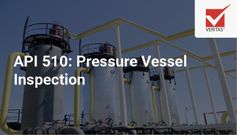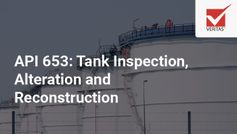Designing according to the ASME BPVC VIII-1 code
Self-Paced Course
8 modules
Daniel van Baalen, MSc
SPC140
Format:
On-demand
€560 For Teams
Get a 20% discount on all courses for you and your team.
Free Course Preview
Help yourself with your purchasing decision. Watch free content now.
Course Objective
"To explain the fundamental equations and principles, thereby creating a solid understanding of the ASME BPVC VIII-1 design code."
Learn from home
100% online training
Video Lectures by Experts
connect with them online
Start immediately
1-year unlimited access
PDH Hours qualified course
Read more here
About the course
Self-paced
8 moduls
6.5 hours
English
1-yr access
SPC140
Design-by-Rules. The ASME VIII-1 design code is the most widely used design code for pressure vessel design. Often the rules are applied using automated software packages such as Compress or PVElite and the engineer can lose the overview of the calculation being performed. This course aims to explain the fundamental equations and principles in the design by rules approach. For example: What is the area replacement rule? How is the Taylor and Forge method applied for flanges? What is the minimum ligament length between nozzles and why? What inter-stiffener distance is required to prevent collapse under vacuum?
Topics include many design features such as design of shells and heads under internal and external pressure, nozzles & openings, flange connections, heat exchanger, tubesheets, saddles and skirts.
As well as explaining the rules and how to apply them, you will be challenged on why a rule is formulated in a particular way.
The course consists of 8 online modules based on video content. You receive 1-year unlimited access to the course and the discussions forum. This allows you to perform modules again when you need to refresh knowledge for your work projects.
Meet your instructor
Program & Details
Welcome to the course
Your instructors
How to use this course
Personal Certificate requirements
Introduction and Agenda
ASME VIII-1 Code Coverage: Outline and Build-up
Materials Aspects and Codes
ASME Section 2 part D: Material Tables
Weld Joint Efficiency in ASME Section 8, division 1
Non Destructibe Testing related to Joint Efficiency Factor
Design Loads - Part 1, 2 & 3
U-stamping for Pressure Vessels
Code Design Stresses and Allowables
Fatique Design in ASME VIII-1
Brittle Fracture: Physical Concepts
Analyzing Brittle Fracture as per the ASME BPVC VIII-1
Module 1, Excercises 1: Weld Joint Efficiencies
Module 1, Excercise 2: Determining the MDMT
A sample of the first module is available for free, so you can learn more about the teaching style and understand if the course fits your needs.
Stress-Strain Relationships and Concepts
Material Stresses for Cylindrical Shells
Load Cases and Failure Modes
Maximum Allowable Values for the Design Stress
Introduction and Agenda
Cylindrical Shells under Internal Pressure
Spherical Shells and Formed Ends
Cones and Conical Sections under Internal Pressure
Introduction and Agenda
Introduction to Buckling for Pressure Vessels
Buckling Examples and Illustrations
Axial Compression Loads as per ASME VIII-1
Compressive Stress: Allowable Value
Cylindrical Shells under External Pressure
Thin Walled Shells: Buckling Evaluation
Buckling Critical Length as per ASME VIII-1
Thick walled Shells: Buckling Evaluation
What are Stiffener Rings?
Using Stiffener Rings as per ASME VIII-1
Vessel Heads under External Pressure - Part 1 & 2
Introduction and Agenda
Shell Openings: An Introduction
Area Replacement Rule as per ASME VIII-1
Area Replacement Rule: Step 1, 2, 3 & 4
Ligament Efficiency Rules as per ASME VIII-1
Ligament Efficiency Rules: Diagonal Lines
Introduction and Agenda
Flat Plates, Covers, Flanges and Design Rules in ASME VIII-1
Bolted Connections as per ASME VIII-1
Gasket Selection for Flanges
Bolt Evaluations for Flanges
Design of Bolted Flanges and Associated Calculations
Calculation Steps for Bolted Connections - Part 1 & 2
Equivalent Pressure Rule for Flange Evaluation
Introduction and Agenda
Types of Heat Exchangers and Analysis Methods
Tubesheet Properties: Calculating Effective Values
Tubesheet Thickness and Related Calculations
Alternative Methodes for Tubesheet Design
Rectangular Vessels as per ASME VIII-1
Openings in Non-Circular Vessels
Half-Pipe Jackets as per ASME VIII-1
Congratulations
Course evaluation survey
Your Personal Certificate
Rate this course
Related resources & follow up
Results
After this course, you...
Have a good overview of the structure and applicability of the AMSE VIII-1 code,
Understand the design rules for most standard components and know the design basis for these rules,
Have performed multiple tutorials to reinforce how to apply the rules,
Are able to identify the limits of the code rules.
Who should attend this course
Those designing pressure vessels with ASME BPVC VIII Div. 1,
Engineers which need to have a solid understanding of the approaches used in the code,
Those that wish to understand the backgrounds and design basis for the code rules.
Prerequisites: Technical background.
Level: Intermediate
Access to the course.
After your purchase is confirmed you receive an account to the EngineeringTrainer online learning portal, where you find the course in your dashboard. After opening the course you will be guided step-by-step through the different modules. You receive 1-year unlimited access to the course. This allows you to perform modules again if this is beneficial for your work projects.
Learn by doing.
The course is mainly based on video content: video lectures and video software demonstrations. English subtitles is available and videos can be viewed as many times as desired. The video lectures help you to grasp the important technical concepts and in the video demonstrations the instructor uses the software and discusses all the steps and actions. You are recommended to follow the steps of the instructor in the software to optimize your learning curve.
Exercises are available in the form of multiple choice quizzes to help you grasp technical concepts and in the form of .pdf-files with instructions to build and analyze different models and answer related questions. Video demonstrations of the exercises are available.
This course is self-paced and is not subject to specific dates. The course contains 8 modules with a total of 6.5 hours of content which can be performed at your own pace. A Personal Certificate will be provided to you if you finish the course within the first month after purchase. This incentive will motivate you to perform the course quickly thereby improving your learning curve.
You receive 1-year unlimited access to all 8 modules. This allows you to perform modules again whenever you want to refresh knowledge for your daily work projects.
A personal digital certificate will be made available to each participant upon full attendance. If you are unable to attend any of the sessions please notify us as you will be required to view the recordings.
Example Certificate:
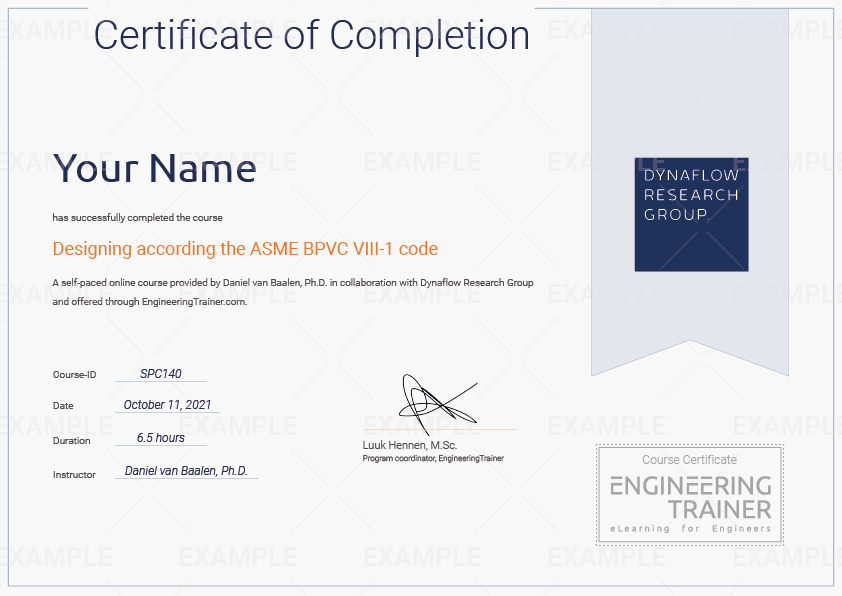
FAQ
Video lectures
Video demonstrations
PDF exercises
Exercise answers by demonstrations (video)
The majority of training material are videos. These are not available for download, but can be accessed directly with your account on the portal. Apart from quizzes the exercise files can be downloaded. These can include .pdf files with the exercise questions, software models or other file types. You receive 1-year unlimited access to the course. This allows you to watch content again if this is beneficial for your work projects.
We encourage participants to submit feedback and questions. These form the basis for new, future videos that will be added to the online course, but they will not be answered to the student directly.
Participants receive 1-year unlimited access to the course including new videos that are added during this year. Participants receive an email notification upon addition of new course videos.
No software is required for participants of this course.
Yes, this course qualifies for PDH hours as per the NCEES CPC Guidelines.
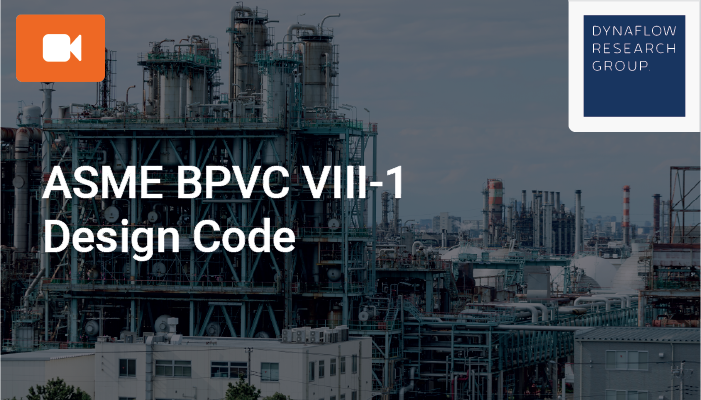
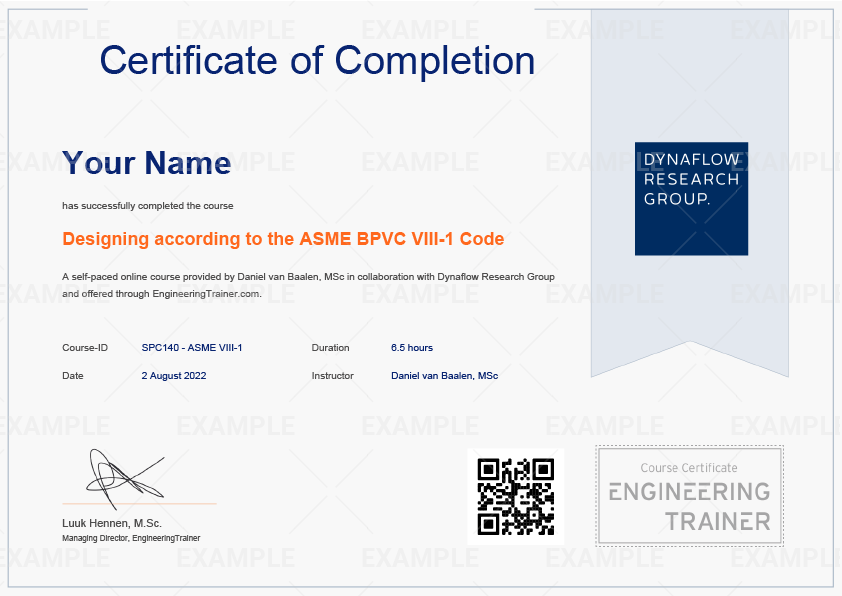


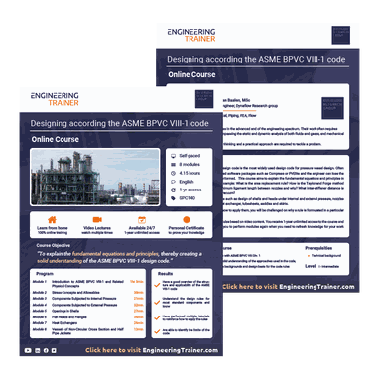

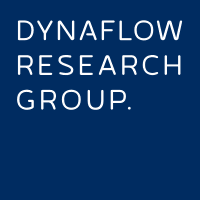
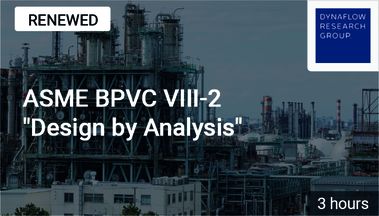
![[SPC118] Designing according the EN13445 code](/web/image/219517/SPC118.png?access_token=913c606c-b08c-42c9-98ad-c82333478665)
